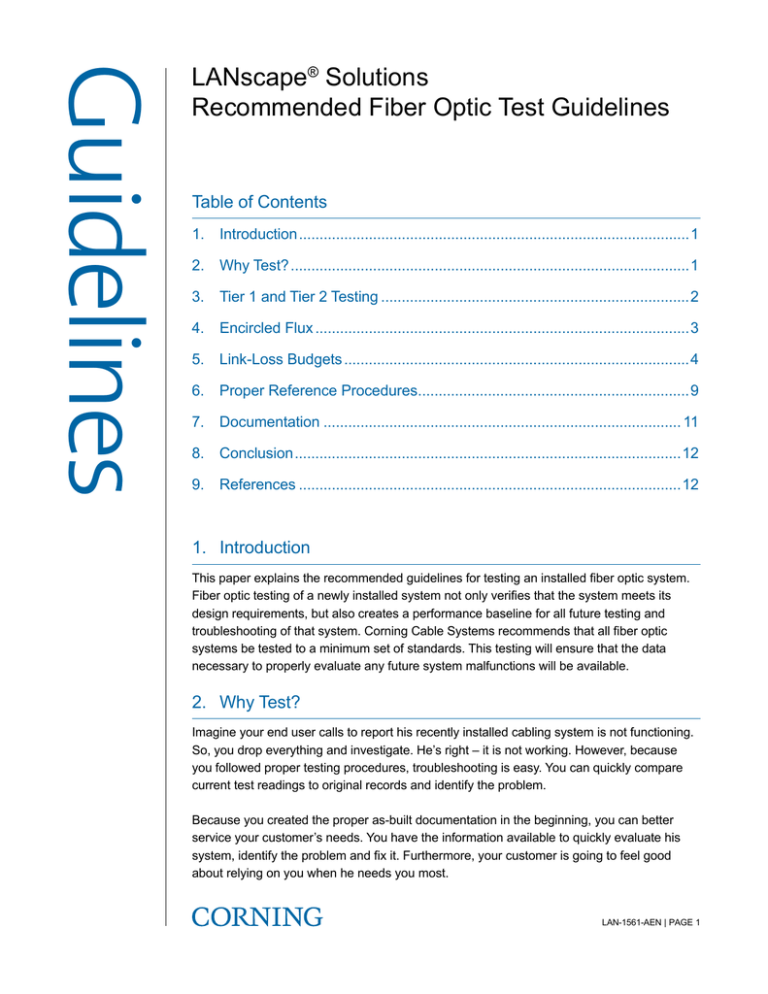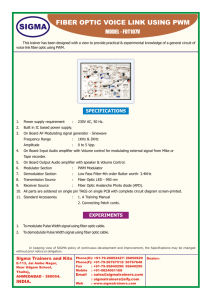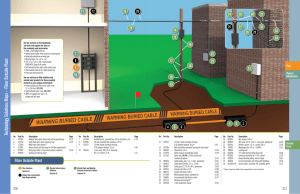Recommended Fiber Optic Test Guidelines - Accu-Tech
advertisement

Guidelines LANscape® Solutions Recommended Fiber Optic Test Guidelines Table of Contents 1. Introduction ...............................................................................................1 2. Why Test? .................................................................................................1 3. Tier 1 and Tier 2 Testing ...........................................................................2 4. Encircled Flux ...........................................................................................3 5. Link-Loss Budgets ....................................................................................4 6. Proper Reference Procedures..................................................................9 7. Documentation ....................................................................................... 11 8. Conclusion ..............................................................................................12 9. References .............................................................................................12 1. Introduction design requirements, but also creates a performance baseline for all future testing and systems be tested to a minimum set of standards. This testing will ensure that the data necessary to properly evaluate any future system malfunctions will be available. 2. Why Test? Imagine your end user calls to report his recently installed cabling system is not functioning. So, you drop everything and investigate. He’s right – it is not working. However, because you followed proper testing procedures, troubleshooting is easy. You can quickly compare current test readings to original records and identify the problem. Because you created the proper as-built documentation in the beginning, you can better service your customer’s needs. You have the information available to quickly evaluate his about relying on you when he needs you most. LAN-1561-AEN | PAGE 1 Guidelines 3. Tier 1 and Tier 2 Testing Tier 2. Tier 1 testing is the minimum level of testing that is required. This level of testing consists of link attenuation testing, ducted at one or more wavelengths, but at a minimum it is recommended that testing be performed at the wave- Figure 1. Tier 1 Testing Installed Fiber Optic System Optical Source Optical Meter same as the wavelengths used for the Tier 1 testing. Tier 2 testing is listed as optional in TIA-568-C.0, but this does not mean it is not important. The OTDR trace can be used for cable acceptance, splice and connector loss, documentation, troubleshooting, fault location, optical return loss and to measure the length of the system. The OTDR LANscape® Solutions Recommended Fiber Optic Test Guidelines | LAN-1561-AEN | PAGE 2 Guidelines ful tool is does not replace the need for Tier 1 testing, because OTDR testing results can vary as a result of user setup. To get a true measurement of an event with an OTDR, a trace needs to be shot from both directions, and the average of the losses needs to be calculated. mating adapters for launch cords is necessary to ensure reliable test results. All launch cords and adapters need to be clean and free of defects prior to and during testing. It is highly recommended that reference-grade launch cords be used for end-to-end attenuation testing. Launch cables should be used for OTDR testing to enable a Figure 2. Tier 2 Testing Installed Fiber Optic System Launch Cable OTDR 4. Encircled Flux tions from source to source. This is also the case because of different procedures used for mandrel wrapping and LANscape® Solutions Recommended Fiber Optic Test Guidelines | LAN-1561-AEN | PAGE 3 Guidelines A conditioned launch can be obtained one of two ways, either with an out-of-port light source or with an outsidewithin the light source, so there is no need for an expensive and limited-use launch conditioner outside the source. Mode Conditioner 4 10% '51*0)$)1*%2 Source !System "#$%& '(Testing %#$)*+',with )$- '.Out-of-Port / $8198: 12$'! 1/ 23%' ; VS. !< !System "#$%& '(Testing %#$)*+',with )$- '.Outside-the/ $#)0%'$- %' Conditioning Jumper ! Source 1/ 23%'4Mode 10%'51*0)$)1*)*+'6/ & 7%2 upgrading their test equipment when feasible. Corning Cable Systems offers an EF compliant solution that provides As installers move toward EF compliance, the Corning Cable Systems stance on mandrel wrapping remains the 5. Link-Loss Budgets determining whether the system was installed correctly, and the combined loss of all installed components is within LANscape® Solutions Recommended Fiber Optic Test Guidelines | LAN-1561-AEN | PAGE 4 Guidelines the active component requirements and intended use of the system. 2. You need to note the wavelength at which the measurements will be taken. The wavelengths should be used for single-mode. 3. The installed cable length can be recorded from the sheath markings on the cable or from an OTDR after loss per TIA-568-C may be used. Table 1 below provides these values. Optical Fiber Type Wavelength (nm) Maximum Attenuation (dB/km) 850 3.5 1300 1.5 850 3.5 1300 1.5 850 3.5 1300 1.5 850 3.5 1300 1.5 1310 0.5 1550 0.5 1310 1.0 1550 1.0 1310 0.5 1550 0.5 The second step is to count the number of connector pairs and the allowable loss for these connector pairs. The The maximum loss value according to TIA standards is 0.75 dB per connector pair. LANscape® Solutions Recommended Fiber Optic Test Guidelines | LAN-1561-AEN | PAGE 5 Guidelines include the splices that are used to connect pigtailed connectors to the system. These splices are a separate ® or ® OptiSnap Connector; this termination should just be included as a single connector. The maximum splice loss according to TIA standards is 0.3 dB. Corning Cable Systems offers a free Link-Loss Budget Calculator on its website. Please follow the provided link. http://www.corning.com/cablesystems/nafta/en/serv_support/techresources/calculators/linkloss.aspx You could also use the following work sheet to manually calculate the link-loss budget. Link-Loss Budget Cable length Fiber attenuation x Total Fiber Loss = Step 2: Determine connector loss. Individual connector loss Number of connector pairs x Total Connector Loss = Step 3: Determine splice loss. Individual splice loss Number of splices x Total Splice Loss = Step 4: Determine total system budget loss. Total Fiber Loss Total Connector Loss + Total Splice Loss + Total Link-Loss Budget = LANscape® Solutions Recommended Fiber Optic Test Guidelines | LAN-1561-AEN | PAGE 6 Guidelines loss value be pulled from Table 1 of this document. ® Connectors. There will be an extension splice will be an ALTOS® The operating wavelength will be 1550 nm. UniCam High-Performance Connectors, LC, Single-Mode Buffer Tube Fan-Out Kit Closet Connector Housing (CCH) Panel CCH Housing Located at Each End of the Cable Splice Closure, Extension Splice ALTOS Loose Tube Cable with Single-Mode Fiber LANscape® Solutions Recommended Fiber Optic Test Guidelines | LAN-1561-AEN | PAGE 7 Guidelines EXAMPLE: Link-Loss Budget for Figure 4. Cable length Fiber attenuation x Total Fiber Loss = 0.5 (dB) Number of connector pairs x 2 Total Connector Loss = 1.5 (dB) Number of splices x 1 Total Splice Loss = 0.3 (dB) Step 2: Determine connector loss. Individual connector loss Step 3: Determine splice loss. Individual splice loss Step 4: Determine total system budget loss. Total Fiber Loss 0.5 (dB) Total Connector Loss + 1.5 (dB) Total Splice Loss + 0.3 (dB) Total Link-Loss Budget = 2.3 (dB) losses. The end user and installer should agree what the budget should be before testing begins. ™ LANscape® Solutions Recommended Fiber Optic Test Guidelines | LAN-1561-AEN | PAGE 8 Guidelines 6. Proper Reference Procedures To perform Tier 1 testing, an important step needs to be completed which is the referencing of the launch cables There are three methods of referencing test jumpers. • One-jumper reference • Two-jumper reference • Three-jumper reference The recommended reference method for the vast majority of end-to-end link testing is the one-jumper reference Test Jumper No. 1 Received power, hit Reference Step 1 Power Source Power Meter Interconnect Sleeve Test Jumper No. 1 Test Jumper No. 2 Step 2 Power Meter Power Source Add jumper 2, check loss ≤ 0.5 dB System Patch Panels Test Jumper No. 1 Test Jumper No. 2 Fiber System Under Test Test System Step 3 Power Source Power Meter LANscape® Solutions Recommended Fiber Optic Test Guidelines | LAN-1561-AEN | PAGE 9 Guidelines one-jumper reference method should be used. One-jumper reference measurement results include the loss within reference method should be used. Two-jumper reference measurement results include the loss of the installed B Installed Fiber Optic System A C Optical Source Optical Meter - LANscape® Solutions Recommended Fiber Optic Test Guidelines | LAN-1561-AEN | PAGE 10 Guidelines 7. Documentation tion allows for easier planning when performing upgrades. It also allows for seamless moves, adds and changes tion will be provided before the job is started. It is good to remember that a good documentation package says a the system owner will see and keep for the life of the system. Documentation can be broken down into two categories: optical and non-optical. Optical documentation includes TIA-568-C.0 recommends the following be included in the optical documentation. For OLTS test results: • Date of the test • Test personnel • • • • • Test equipment calibration date Type and length of the reference jumpers Fiber ID Test procedure and reference method used Link-loss results For OTDR test results: • Date of the test • Test personnel • • • Test equipment calibration date Type and length of the launch cables Fiber ID • Tested wavelengths LANscape® Solutions Recommended Fiber Optic Test Guidelines | LAN-1561-AEN | PAGE 11 Guidelines 8. Conclusion systems. It was not meant to replace the standards, but to clarify them and provide guidance to ensure the proper steps are taken before, during and after testing. These guidelines include building the proper loss budget based on installed components, determining the necessary tests to be performed, using the correct test equipment referencing method and delivering a complete and informative documentation package. Following all the outlined steps ized to include the system’s capabilities and limitations. 9. References Cable Plant Cable Plant 7. 8. 9. 10. 11. AEN 104: Standards Compliant Optical Test Equipment and Test Procedures AEN 115: Plug & Play™ Link Loss Budget Determination AEN 129: What is Encircled Flux and other related questions AEN 134: OTDR Testing Basics AEN 135: Fiber Optic System Testing Tutorial Corning Cable Systems LLC • PO Box 489 • Hickory, NC 28603-0489 USA 800-743-2675 • FAX: 828-325-5060 • International: +1-828-901-5000 • www.corning.com/cablesystems Corning Cable Systems reserves the right to improve, enhance and modify the features and specifications of Corning Cable Systems products without prior notification. ALTOS, Cable Systems Brands, Inc. All other trademarks are the properties of their respective owners. LANscape® Solutions Recommended Fiber Optic Test Guidelines | LAN-1561-AEN | PAGE 12




